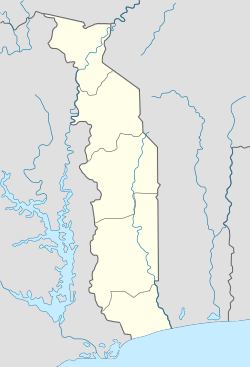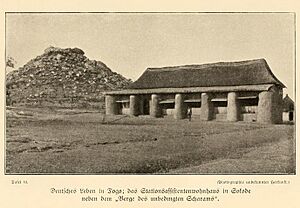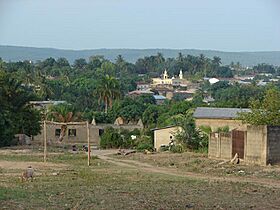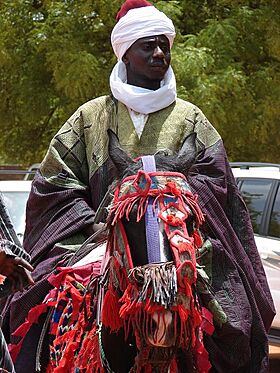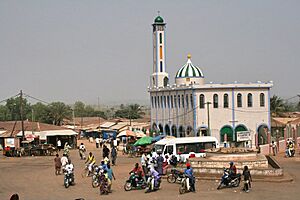Sokodé facts for kids
Quick facts for kids
Sokodé
|
|
|---|---|
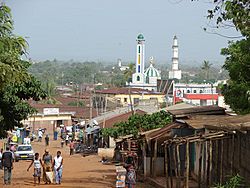
Downtown Sokodé
|
|
| Country | |
| Region | Centrale Region |
| Prefecture | Tchaoudjo |
| Elevation | 340 m (1,120 ft) |
| Population
(2015)
|
|
| • Total | 189,000 |
Sokodé is the second-biggest city in Togo. About 189,000 people live there. It's a busy place for trade, especially for nearby farms. It's also the main city for the Tchaoudjo area and the Centrale Region.
You can find it in the middle of Togo, about 339 kilometers (210 miles) north of Lomé, the capital city. It sits between the Mo and Mono rivers. Sokodé is home to many different groups of people and religions. However, most people follow Islam. The largest ethnic group is the Kotokolis, who live alongside other Muslim communities.
Contents
History of Sokodé
The first people in this area mixed with new groups called Gurma. These Gurma people came from the eastern part of the Niger Bend. They brought a system of leadership with chiefs. Later, traders and craftspeople from Sudan, like the Mandinka and Hausa, also arrived. These groups were very active from the 1500s.
In 1897, the Germans set up an outpost in Sokodé. This made the Kotokoli chiefs even more powerful.
The city grew a lot before colonial times. It was an important trading spot on the Kola nut route between Ghana and Benin. Today, it's a key center on Togo's only main north-south road. This road connects Lomé to Burkina Faso. The city grew even faster during the time of colonization. Sokodé is made up of older villages that have now become neighborhoods.
Sokodé is still run by both a city government and traditional chiefs. In the past, chiefs from different villages formed a council called the Tchaoudjo.
Geography and Rivers
The area around Sokodé has many rivers and hills. The two main rivers are the Kpondjo and Kpandi. These rivers flow into the Na, which then joins the Mono River. The line that divides the water flowing into the Mono River from the water flowing into the Volta River is just a few kilometers north of the city. Sokodé is now in the area where water flows into the river Mô.
People and Languages
Sokodé has the highest number of Muslims in Togo. About 70% of the people are Muslim. The other 30% are Christians, mostly Catholics. The main ethnic group in Sokodé is the Tem people. Most people in Sokodé speak Kotokoli (also called Tem). The name Kotokoli was given to these speakers by traders from the Niger Bend.
Many other languages are spoken in Togo. These include Ewé, which is common in the south, and Kabyé, which is common in the Kara region further north. The Kotokoli and Kabyè languages are quite similar.
The city itself has two main parts. The center has many traditional houses built close together. The outer areas, or suburbs, have houses that are more spread out. Modern building materials are slowly replacing older ones, like mudbrick.
Climate and Seasons
Sokodé is about 340 meters (1,115 feet) above sea level. It's located between the ocean and the dry Sahel region. The city has a tropical savanna climate. This means it has two clear seasons.
The rainy season lasts from April to October, with the most rain from July to September. The dry season is from November to March. Sokodé gets between 1,200 and 1,500 millimeters (47 to 59 inches) of rain each year. It rains on about 100 to 130 days. The average temperature is around 26°C (79°F). A dry wind called the harmattan blows from November to January.
| Climate data for Sokodé (1991–2020, extremes 1901–present) | |||||||||||||
|---|---|---|---|---|---|---|---|---|---|---|---|---|---|
| Month | Jan | Feb | Mar | Apr | May | Jun | Jul | Aug | Sep | Oct | Nov | Dec | Year |
| Record high °C (°F) | 40.5 (104.9) |
41.0 (105.8) |
40.5 (104.9) |
40.5 (104.9) |
38.0 (100.4) |
36.5 (97.7) |
38.5 (101.3) |
38.0 (100.4) |
35.7 (96.3) |
40.5 (104.9) |
39.9 (103.8) |
38.0 (100.4) |
41.0 (105.8) |
| Mean daily maximum °C (°F) | 34.8 (94.6) |
36.3 (97.3) |
36.5 (97.7) |
34.7 (94.5) |
33.0 (91.4) |
31.1 (88.0) |
29.6 (85.3) |
29.0 (84.2) |
30.2 (86.4) |
32.2 (90.0) |
34.5 (94.1) |
34.4 (93.9) |
33.0 (91.4) |
| Daily mean °C (°F) | 27.0 (80.6) |
28.8 (83.8) |
29.8 (85.6) |
29.0 (84.2) |
27.8 (82.0) |
26.5 (79.7) |
25.6 (78.1) |
25.3 (77.5) |
25.8 (78.4) |
26.3 (79.3) |
26.9 (80.4) |
26.5 (79.7) |
27.1 (80.8) |
| Mean daily minimum °C (°F) | 19.2 (66.6) |
21.4 (70.5) |
23.1 (73.6) |
23.2 (73.8) |
22.6 (72.7) |
21.8 (71.2) |
21.5 (70.7) |
21.5 (70.7) |
21.3 (70.3) |
21.2 (70.2) |
19.3 (66.7) |
18.5 (65.3) |
21.2 (70.2) |
| Record low °C (°F) | 10.0 (50.0) |
11.0 (51.8) |
15.8 (60.4) |
18.0 (64.4) |
18.0 (64.4) |
16.0 (60.8) |
16.0 (60.8) |
16.8 (62.2) |
15.5 (59.9) |
16.0 (60.8) |
11.0 (51.8) |
10.0 (50.0) |
10.0 (50.0) |
| Average precipitation mm (inches) | 4.3 (0.17) |
13.0 (0.51) |
38.8 (1.53) |
101.6 (4.00) |
119.4 (4.70) |
149.0 (5.87) |
219.5 (8.64) |
258.3 (10.17) |
249.5 (9.82) |
111.3 (4.38) |
13.3 (0.52) |
0.9 (0.04) |
1,278.9 (50.35) |
| Average precipitation days (≥ 1.0 mm) | 0.4 | 1.1 | 4.6 | 8.7 | 11.9 | 13.9 | 18.8 | 21.4 | 19.9 | 11.3 | 1.4 | 0.3 | 113.7 |
| Average relative humidity (%) | 35 | 49 | 64 | 71 | 76 | 82 | 84 | 85 | 86 | 80 | 69 | 54 | 70 |
| Mean monthly sunshine hours | 262.9 | 243.1 | 235.0 | 214.7 | 220.2 | 174.8 | 124.7 | 110.4 | 135.5 | 213.9 | 250.6 | 256.0 | 2,441.8 |
| Source 1: NOAA (sun 1961-1990), | |||||||||||||
| Source 2: Deutscher Wetterdienst (humidity 1961-1990) Meteo Climat (record highs and lows) | |||||||||||||
Economy and Farming
The economy in Sokodé mainly relies on transport, trade, and making things by hand. There isn't much big industry, except for processing cotton and sugar.
Farmers in the area mostly grow corn, cassava, yams, pepper, and beans. Many gardeners and farmers live on the edges of Sokodé. They also raise cows in their fields. Nomadic Fulani people often pass near Sokodé with their herds of zebu cattle. They are usually traveling between Burkina Faso and Nigeria.
Vegetables are grown especially along the Kpondjo and Inusayo rivers. Most of these farming areas are floodplains. Farmers start planting after the rainy season ends.
Culture and Festivals
Main Festivals
The main Kotokoli festival is called Gadao-Adossa-Kosso. It lasts for three days, from Friday to Sunday.
- Gadao is celebrated on the evening before Adossa. People thank their ancestors for good harvests.
- Adossa, also known as the Festival of Knives, is a special ceremony. It comes from the Semassi warriors. They show their strength and bravery by doing physical challenges.
- The next day is Kosso, the Festival of Women. During Kosso, women dance in the Municipal Park in Sokodé City.
Other important festivals are also held by different family groups in Sokodé. At most festivals, traditional dancers from the region are invited. Riders who act like the Semassi warriors also perform, spinning very fast in the crowd.
Places of Worship
Sokodé has many places of worship. Most of them are Muslim mosques. There are also Christian churches and temples. These include the Roman Catholic Diocese of Sokodé (Catholic Church), the Evangelical Presbyterian Church of Togo (World Communion of Reformed Churches), the Togo Baptist Convention (Baptist World Alliance), Living Faith Church Worldwide, Redeemed Christian Church of God, and Assemblies of God.
Sports Teams
The city is home to two football clubs: AC Semassi F.C. and Tchaoudjo Athlétic Club. Both teams play their games at the Stade Municipal.
Famous People from Sokodé
- Kotokro - He was the founder of Sokodé.
- Zarifou Ayéva - A well-known politician.
- Mohamed Kader - A professional footballer.
- Edem Kodjo - He used to be the Prime Minister of Togo.
- Assimiou Touré - A professional footballer.
- Arissou Traorè - A professional footballer.
Images for kids
See also
 In Spanish: Sokodé para niños
In Spanish: Sokodé para niños


